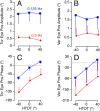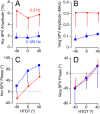Ocular Reflex Phase during Off-Vertical Axis Rotation in Humans is Modified by Head-Turn-On-Trunk Position
- PMID: 28176802
- PMCID: PMC5296736
- DOI: 10.1038/srep42071
Ocular Reflex Phase during Off-Vertical Axis Rotation in Humans is Modified by Head-Turn-On-Trunk Position
Abstract
Constant velocity Off-Vertical Axis Rotation (OVAR) imposes a continuously varying orientation of the head and body relative to gravity, which generates a modulation of horizontal (conjugate and vergence), vertical, and torsional eye movements. We introduced the head-turn-on-trunk paradigm during OVAR to examine the extent to whether the modulation of these ocular reflexes is mediated by graviceptors in the head, i.e., otoliths, versus other body graviceptors. Ten human subjects were rotated in darkness about their longitudinal axis 20° off-vertical at a constant velocity of 45 and 180°/s, corresponding to 0.125 and 0.5 Hz. Binocular responses were obtained with the head and trunk aligned, and then with the head turned relative to the trunk 40° to the right or left of center. The modulation of vertical and torsional eye position was greater at 0.125 Hz while the modulation of horizontal and vergence slow phase velocity was greater at 0.5 Hz. The amplitude modulation was not significantly altered by head-on-trunk position, but the phases shifted towards alignment with the head. These results are consistent with the modulation of ocular reflexes during OVAR being primarily mediated by the otoliths in response to the sinusoidally varying linear acceleration along the interaural and naso-occipital head axis.
Conflict of interest statement
The authors declare no competing financial interests.
Figures




Similar articles
-
Three-dimensional organization of otolith-ocular reflexes in rhesus monkeys. I. Linear acceleration responses during off-vertical axis rotation.J Neurophysiol. 1996 Jun;75(6):2405-24. doi: 10.1152/jn.1996.75.6.2405. J Neurophysiol. 1996. PMID: 8793753
-
Three-dimensional organization of otolith-ocular reflexes in rhesus monkeys. II. Inertial detection of angular velocity.J Neurophysiol. 1996 Jun;75(6):2425-40. doi: 10.1152/jn.1996.75.6.2425. J Neurophysiol. 1996. PMID: 8793754
-
Translational otolith-ocular reflex during off-vertical axis rotation in humans.Neurosci Lett. 2016 Mar 11;616:65-9. doi: 10.1016/j.neulet.2016.01.049. Epub 2016 Jan 28. Neurosci Lett. 2016. PMID: 26827718
-
Compensatory and orienting eye movements induced by off-vertical axis rotation (OVAR) in monkeys.J Neurophysiol. 2002 Nov;88(5):2445-62. doi: 10.1152/jn.00197.222. J Neurophysiol. 2002. PMID: 12424285
-
Origin and processing of postural information.Neurosci Biobehav Rev. 1998 Jul;22(4):473-8. doi: 10.1016/s0149-7634(97)00032-8. Neurosci Biobehav Rev. 1998. PMID: 9595557 Review.
Cited by
-
Enhancing vestibular function in the elderly with imperceptible electrical stimulation.Sci Rep. 2018 Jan 10;8(1):336. doi: 10.1038/s41598-017-18653-8. Sci Rep. 2018. PMID: 29321511 Free PMC article.
-
Both whole-body rotation and visual flow induce cardiovascular autonomic response in human, but visual response is overridden by vestibular stimulation.Sci Rep. 2023 Mar 14;13(1):4191. doi: 10.1038/s41598-023-31431-z. Sci Rep. 2023. PMID: 36918631 Free PMC article.
References
-
- Guedry F. E. Jr. Orientation of the rotation-axis relative to gravity: Its influence on nystagmus and the sensation of rotation. Acta Otolaryngol 60, 30–48 (1965). - PubMed
-
- Angelaki D. E. & Hess B. J. Three-dimensional organization of otolith-ocular reflexes in rhesus monkeys. I. Linear acceleration responses during off-vertical axis rotation. J Neurophysiol 75, 2405–2424 (1996). - PubMed
-
- Dai M., Raphan T., Kozlovskaya I. & Cohen B. Modulation of vergence by off-vertical yaw axis rotation in the monkey: normal characteristics and effects of space flight. Exp Brain Res 111, 21–29 (1996). - PubMed
LinkOut - more resources
Full Text Sources
Other Literature Sources

